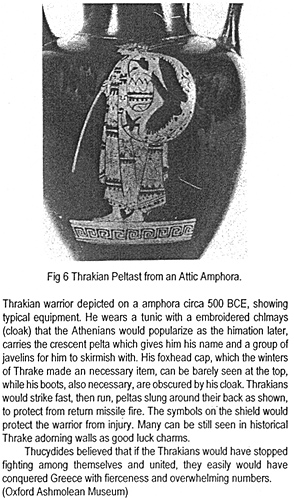Thrakian Peltast from an Attic Amphora.
Thrakian warrior depicted on a amphora circa 500 BCE, showing typical equipment. He wears a tunic with a embroidered chimays (cloak) that the Athenians would popularize as the himation later, carries the crescent pelta which gives him his name and a group of javelins for him to skirmish with. His foxhead cap, which the winters of Thrake made an necessary item, can be barely seen at the top, while his boots, also necessary, are obscured by his cloak. Thrakians would strike fast, then run, peltas slung around their back as shown, to protect from return missile fire. The symbols on the shield would protect the warrior from injury. Many can be still seen in historical Thrake adorning walls as good luck charms.
Thucydides believed that if the Thrakians would have stopped fighting among themselves and united, they easily would have conquered Greece with fierceness and overwhelming numbers. (Oxford Ashmolean Museum)

The Peltast in Classical Greece
-
Preface and Introduction
What is a Peltast?
Speed and Maneuverability
Equipment and Function
Effectiveness in Battle
Conclusion and Bibliography
Peltasts in Action Diagram (27K)
Peltasts on Attic Amphora (86K)
Peltasts on Attic Cup (73K)
Back to Strategikon Vol. 2 No. 2 Table of Contents
Back to Strategikon List of Issues
Back to MagWeb Master Magazine List
© Copyright 2002 by NMPI
This article appears in MagWeb.com (Magazine Web) on the Internet World Wide Web. Other articles from military history and related magazines are available at http://www.magweb.com